Influence of Soluble Salt NaCl on Cracking Characteristics and Mechanism of Loess
Abstract
1. Introduction
2. Materials and Methods
2.1. Materials
2.2. Experimental Methods
2.2.1. Free Desiccation Test
2.2.2. Preparation of Loess Samples with Different NaCl Concentration
2.2.3. Analysis of Crack Parameters with PCAS
2.2.4. Digital Image Correlation Method
- U (mm)—longitudinal displacement along x axis;
- V (mm)—transversal displacement along y axis;
- (%)—longitudinal strain along x axis;
- (%)—transversal strain along y axis;
- (%)—shear strain.
2.3. Microstructure Analysis with SEM
3. Results and Discussion
3.1. Influence of NaCl to the Characteristics of Cracks in Loess
3.2. Influence of NaCl on Cracking Mechanisms in Loess
3.3. Microscopic Cracking Mechanism of Loess with Different NaCl Concentration
4. Conclusions
- (1)
- With the increase in NaCl concentration, the evaporation rate of loess samples gradually decreases and the residual water content gradually increases during the free-drying process.
- (2)
- NaCl in the loess sample will restrain the development of cracks in loess. With the increase in NaCl concentration in the loess sample, some parameters of cracks in the loess sample, such as crack ratio, numbers, and total length, decrease.
- (3)
- Based on the local displacements and strains measurement results of the loess sample, the evolution characteristics of cracks can be predicted. The cracking modes in loess can be classified as opening, sliding and mixed opening–sliding modes. The concentration of NaCl does not affect the cracking modes of loess. The increase in NaCl reduces the accumulation capacity of energy in loess samples and decreases the rate of crack evolution.
- (4)
- During the free desiccation process, the NaCl in the loess sample will react with the mineral components in the clay to form a smooth layer, which has the function of cementing clay particles and making the soil structure compact. The cementation increases with the increase in NaCl concentration, thus restraining the crack evolution.
Author Contributions
Funding
Institutional Review Board Statement
Informed Consent Statement
Data Availability Statement
Acknowledgments
Conflicts of Interest
References
- Xu, L.; Coop, M.R.; Zhang, M.S.; Wang, G.L. The mechanics of a saturated silty loess and implications for landslides. Eng. Geol. 2018, 236, 29–42. [Google Scholar] [CrossRef]
- Rogers, C.D.F.; Dijkstra, T.A.; Smalley, I.J. Hydroconsolidation and subsidence of loess: Studies from China, Russia, North America and Europe. Eng. Geol. 1994, 37, 83–113. [Google Scholar] [CrossRef]
- DeCarlo, K.F.; Shokri, N. Slinity effects on cracking morphology and dynamics in 3-D desiccating clays. Water Resour. Res. 2013, 50, 3052–3072. [Google Scholar] [CrossRef]
- Zuo, L.; Xu, L.; Baudet, B.A.; Gao, C.Y.; Huang, C. The structure degradation of a silty loess induced by long-term water seepage. Eng. Geol. 2020, 272, 105634. [Google Scholar] [CrossRef]
- Yesiller, N.; Miller, C.J.; Inci, G.; Yaldo, K. Desiccation and cracking behavior of three compacted landfill liner soils. Eng. Geol. 2000, 57, 105–121. [Google Scholar] [CrossRef]
- Morris, P.H.; Graham, J.; Williams, D.J. Cracking in drying soils. Can. Geotech. J. 1992, 29, 263–277. [Google Scholar] [CrossRef]
- Miller, C.J.; Mi, H.; Yesiller, N. Experimental analysis of desiccation cracking propagation in clay liners. J. Am. Water Resour. Assoc. 1998, 34, 677–686. [Google Scholar] [CrossRef]
- Tang, C.S.; Shi, B.; Liu, C.; Zhao, L.Z.; Wang, B.J. Influencing factors of geometrical structure of surface shrinkage cracks in clayey soils. Eng. Geol. 2008, 101, 204–217. [Google Scholar] [CrossRef]
- An, N.; Tang, C.S.; Xu, S.K.; Gong, X.P.; Shi, B.; Inyang, H.I. Effects of soil characteristics on moisture evaporation. Eng. Geol. 2018, 239, 126–135. [Google Scholar] [CrossRef]
- Li, H.D.; Tang, C.S.; Cheng, Q.; Li, S.J.; Gong, X.P.; Shi, B. Tensile strength of clayey soil and the strain analysis based on image processing techniques. Eng. Geol. 2019, 253, 137–148. [Google Scholar] [CrossRef]
- Tang, C.S.; Zhu, C.; Leng, T.; Shi, B.; Cheng, Q.; Zeng, H. Three-dimensional characterization of desiccation cracking behavior of compacted clayey soil using X-ray computed tomography. Eng. Geol. 2019, 255, 1–10. [Google Scholar] [CrossRef]
- Wang, L.L.; Tang, C.S.; Shi, B.; Cui, Y.J.; Zhang, G.Q.; Hilary, I. Nucleation and propagation mechanisms of soil desiccation cracks. Eng. Geol. 2018, 238, 27–35. [Google Scholar] [CrossRef]
- Jiang, N.J.; Tang, C.S.; Yin, L.Y.; Xie, Y.H.; Shi, B. Applicability of Microbial Calcification Method for Sandy-Slope Surface Erosion Control. J. Mater. Civil Eng. 2019, 31, 04019250. [Google Scholar] [CrossRef]
- Zuo, L.; Lv, B.R.; Xu, L.; Li, L.W. The influence of salt contents on the compressibility of remolded loess soils. Bull. Eng. Geol. Environ. 2022, 81, 185. [Google Scholar] [CrossRef]
- Péron, H.; Herchel, T.; Laloui, L. Fundamentals of desiccation cracking of fine-grained soils experimental characterization and mechanisms identification. Can. Geotech. J. 2009, 46, 1177–1201. [Google Scholar] [CrossRef]
- Corte, A.; Higashi, A. Experimental Research on Desiccation Cracks in Soils; U.S. Army Snow Ice and Permafrost Research Establishment, Research Report No. 66; Corps of Engineers: Wilmette, IL, USA, 1960. [Google Scholar]
- Xu, L.; Coop, M.R. Influence of structure on the behaviour of a saturated clayey loess. J. Can. Geotech. 2016, 53, 1026–1037. [Google Scholar] [CrossRef]
- Wei, X.; Hattab, M.; Taibi, S.; Bicalho, K.V.; Xu, L.; Fleureau, J.M. Crack development and coalescence process in drying clayey loess. Geomech. Eng. 2021, 25, 535–552. [Google Scholar]
- Wei, X.; Bicalho, K.V.; Hajjar, A.E.; Taibi, S.; Hattab, M.; Fleureau, J.M. Experimental techniques for the study of the cracking mechanisms in drying clays. Geotech. Test. J. 2020, 44, 323–338. [Google Scholar] [CrossRef]
- Waler, P. Irrigation on Swelling Clays Soils. Master’s Thesis, Agricultural Engineering, Central Region, Moldova, 1989. [Google Scholar]
- Shokri, N.; Zhou, P.; Keshmiri, A. Patterns of desiccation cracks in saline bentonite layers. Transp. Porous Med. 2015, 110, 333–344. [Google Scholar] [CrossRef]
- Wei, X.; Hattab, M.; Bompard, P. Highlighting some mechanisms of crack formation and propagation in clays on drying path. Géotechnique 2016, 66, 287–300. [Google Scholar] [CrossRef]
- Wei, X.; Hattab, M.; Fleureau, J.M. Micro-macro-experimental study of two clayey materials on drying paths. Bull. Eng. Geol. Environ. 2013, 72, 495–508. [Google Scholar] [CrossRef]
- Kodikara, J.; Costa, S. Desiccation cracking in clayey Soils: Mechanisms and Modelling. In Multiphysical testing of Soils and Shales; Springer: Berlin/Heidelberg, Germany, 2013; pp. 21–32. [Google Scholar]
- Li, J.H.; Li, L.; Chen, R. Cracking and vertical preferential flow through landfill clay liners. Eng. Geol. 2016, 206, 33–41. [Google Scholar] [CrossRef]
- Wang, D.Y.; Tang, C.S.; Shi, B. Studying the effect of drying on soil hydromechanical properties using micro-penetration method. Environ. Earth Sci. 2016, 75, 1–13. [Google Scholar]
- Zhang, X.D.; Chen, Y.G.; Ye, W.M. Effect of salt concentration on desiccation cracking behavior of GMZ bentonite. Environ. Earth Sci. 2017, 76, 531. [Google Scholar] [CrossRef]
- Tang, C.S.; Shi, B.; Liu, C.; Suo, W.B.; Gao, L. Experimental characterization of shrinkage and desiccation cracking in thin clay layer. Appl. Clay Sci. 2011, 52, 69–77. [Google Scholar] [CrossRef]
- Lakshmikantha, M.R.; Prat, P.C.; Ledesma, A. An Experimental Study of Cracking Mechanisms in Drying Soils; Thomas Telford Publishing: London, UK, 2006; pp. 533–540. [Google Scholar]
- Cordero, J.A.; Useche, G.; Prat, P.C. Soil desiccation cracks as a suction–contraction process. Géotech. Lett. 2017, 7, 279–285. [Google Scholar] [CrossRef]
- Lu, H.; Li, J.; Wang, W. Cracking and water seepage of Xiashu loess used as landfill cover under wetting–drying cycles. Environ. Earth Sci. 2015, 74, 7441–7450. [Google Scholar] [CrossRef]
- Zhang, Y.S.; Qu, Y.X. Cements of sand loess and their cementation in North Shaan Xi and West Shan Xi. J. Eng. Geol. 2005, 13, 18–28, (In Chinese with English abstract). [Google Scholar]
- Liu, D.S. (Ed.) Loess and the Environment; Science Press: Beijing, China, 1985. [Google Scholar]
- Liu, C.; Shi, B.; Zhou, J.; Tang, C.S. Quantification and characterization of microporosity by image processing, geometric measurement and statistical methods: Application on SEM images of clay materials. Appl. Clay Sci. 2011, 54, 97–106. [Google Scholar] [CrossRef]
- Liu, C.; Tang, C.S.; Shi, B. Automatic quantification of crack patterns by image processing. Comput. Geosci. 2013, 57, 77–80. [Google Scholar] [CrossRef]
- Zeng, H.; Tang, C.S.; Cheng, Q.; Zhu, C.; Yin, L.Y.; Shi, B. Drought induced soil desiccation cracking behavior with consideration of basal friction and layer thickness. Water Resour. Res. 2019, 56, e2019WR026948. [Google Scholar] [CrossRef]
- Fang, H.Q.; Ding, X.M.; Jiang, C.Y.; Peng, Y.; Wang, C.Y. Effects of layer thickness and temperature on desiccation cracking characteristics of coral clay. Bull. Eng. Geol. Environ. 2022, 81, 391. [Google Scholar] [CrossRef]
- Wei, X.; Yang, Z.T.; Fleureau, J.M.; Hattab, M.; Taibi, S.; Xu, L. Tensile strength identification of remolded clayey soils. Bull. Eng. Geol. Environ. 2022, 81, 405. [Google Scholar] [CrossRef]
- Lebron, I.; Suarez, D.I.; Schaap, M.G. Soil pore size and geometry as a result of aggregate-size distribution and chemical composition. Soil Sci. 2002, 167, 165–172. [Google Scholar] [CrossRef]
- Malik, M.; Mustafa, M.A.; Letey, J. Effect of mixed Na/Ca solutions on swelling, dispersion and transient water flow in unsaturated montmorillonitic soils. Geoderma 1992, 52, 17–28. [Google Scholar] [CrossRef]
- Shokri, N.; Lehmann, P.; Vontobel, P.; Or, D. Drying front and water content dynamics during evaporation from sand delineated by neutron radiography. Water Resour. Res. 2008, 44, 1–11. [Google Scholar] [CrossRef]
- Ding, J.; Yu, D. Monitoring and evaluating spatial variability of soil salinity in dry and wet seasons in the Werigan-Kuqa Oasis, China, using remote sensing and electromagnetic induction instruments. Geoderma 2014, 235–236, 316–322. [Google Scholar] [CrossRef]
- Feikema, P.M.; Baker, T.G. Effect of soil salinity on growth of irrigated plantation eucalyptus in south-eastern Australia. Agric. Water Manag. 2011, 98, 1180–1188. [Google Scholar] [CrossRef]
- Zhang, G.H.; Yu, Q.C.; Wei, G.Q.; Chen, B.; Yang, L.S.; Hu, C.Y.; Li, J.P.; Chen, H.H. Study on the basic properties of the soda-saline soils in Songnen plain. Hydrogeol. Eng. Geol. 2007, 2, 37–40. [Google Scholar]
- Zhang, Y.; Hu, Z.; Li, L. Improving the structure and mechanical properties of loess by acid solutions—An experimental study. Eng. Geol. 2018, 244, 132–145. [Google Scholar] [CrossRef]
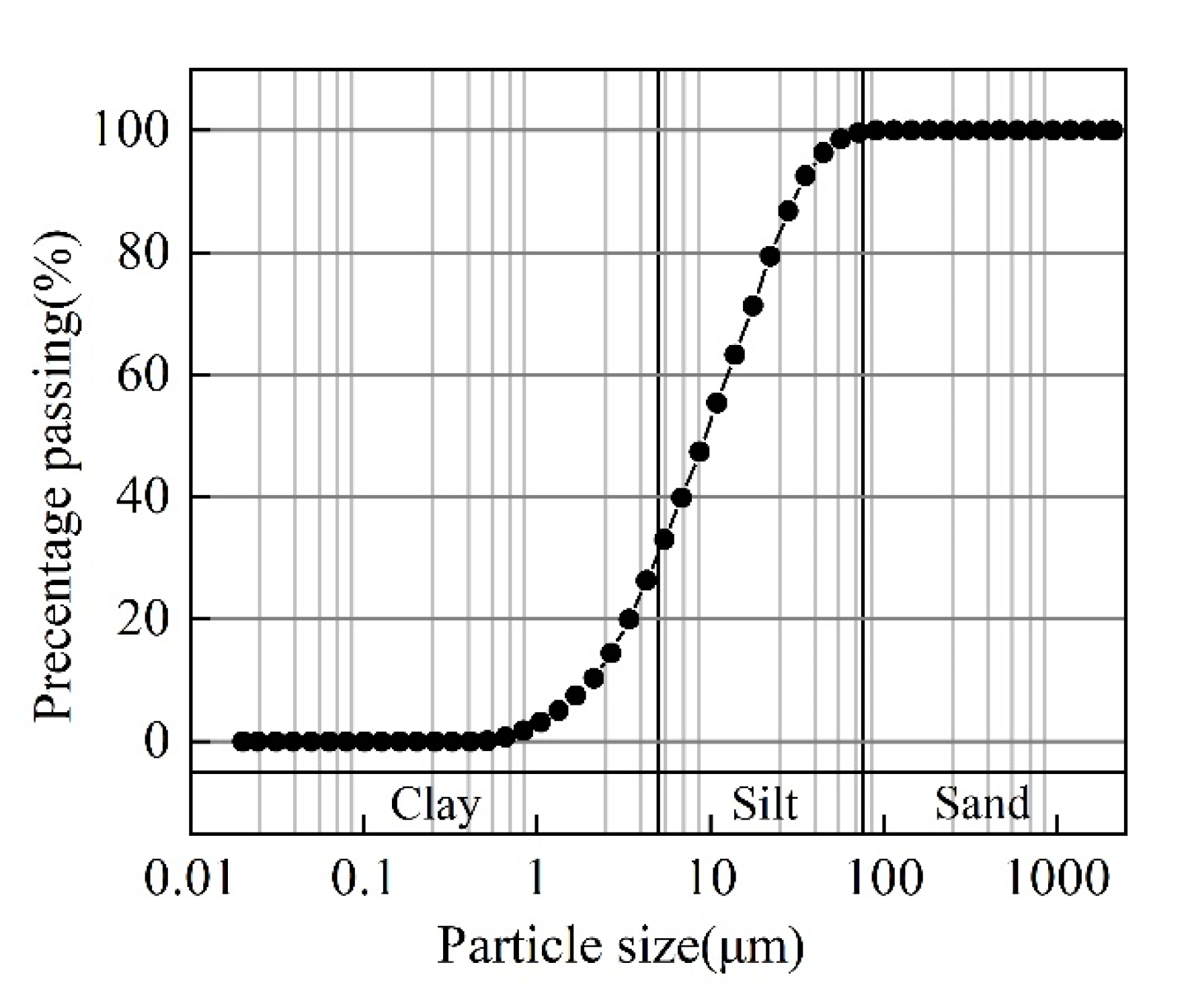
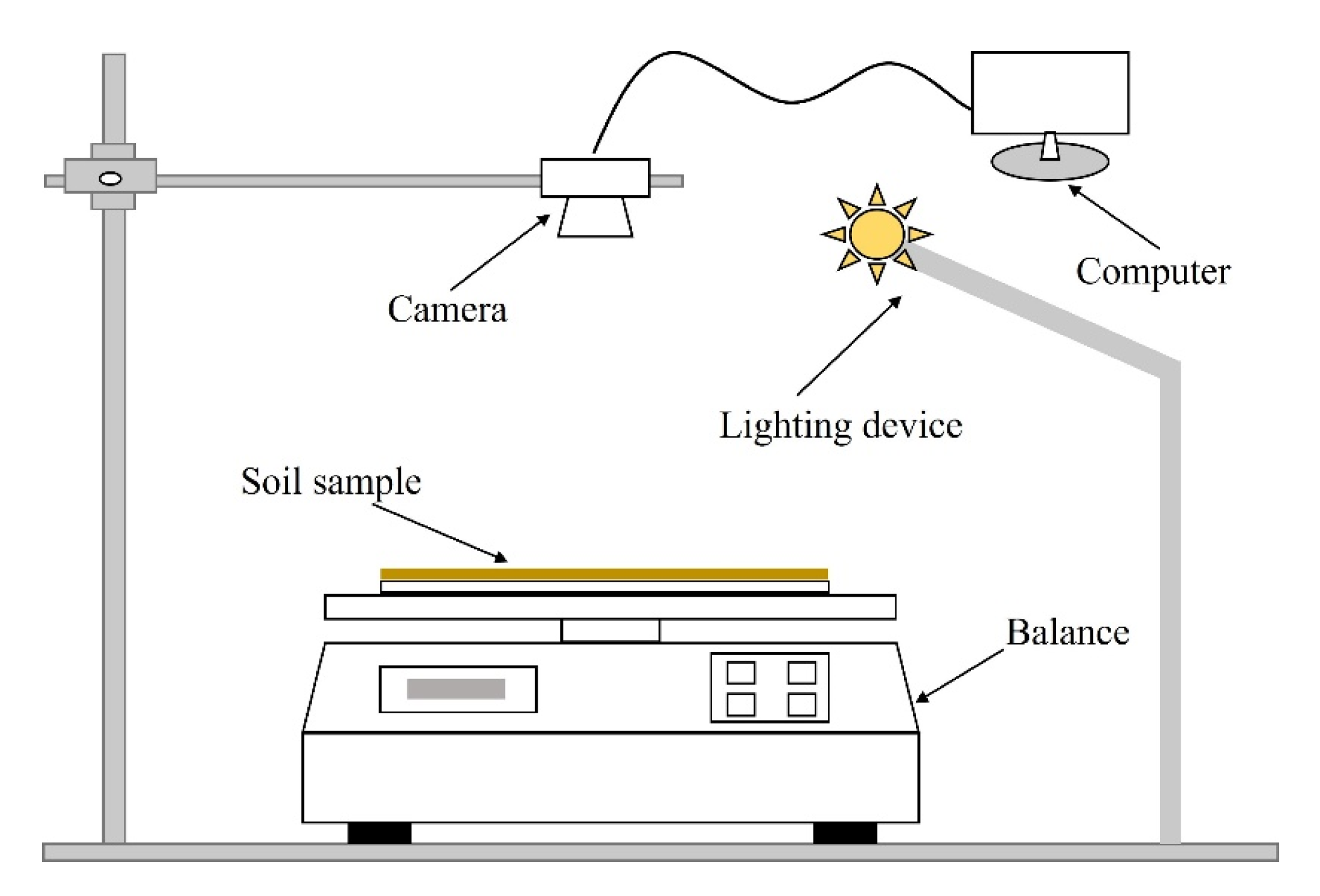








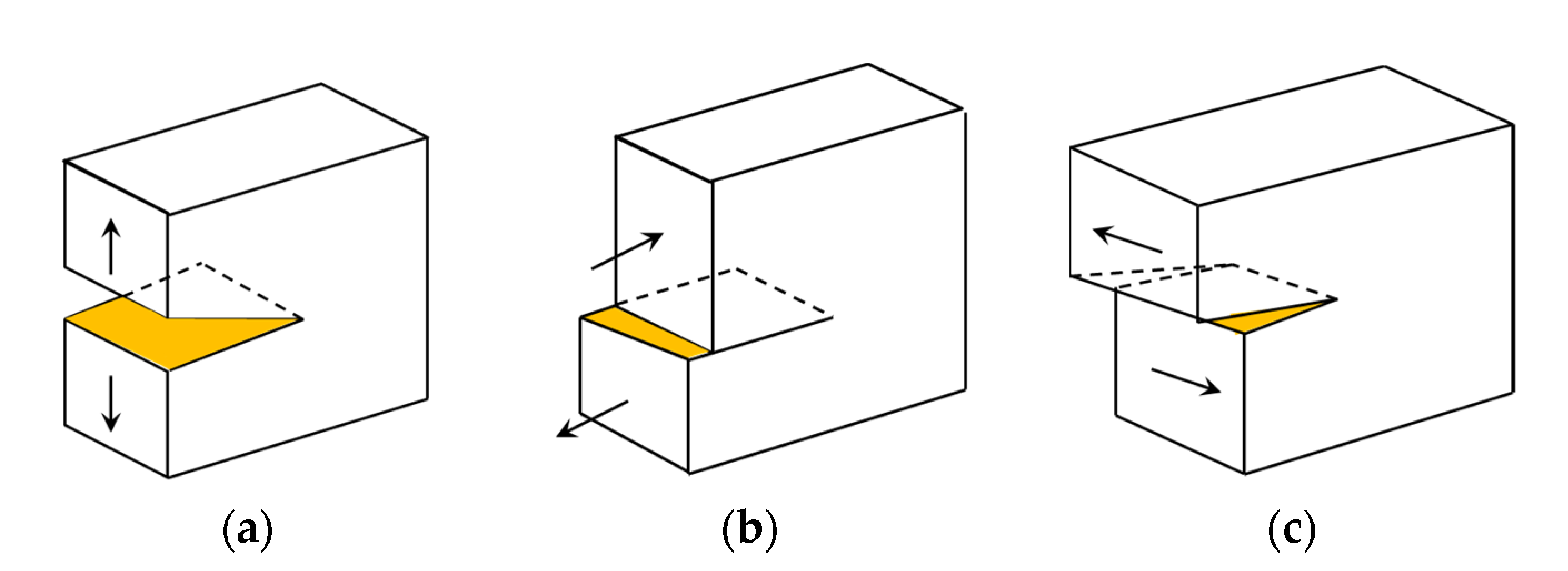

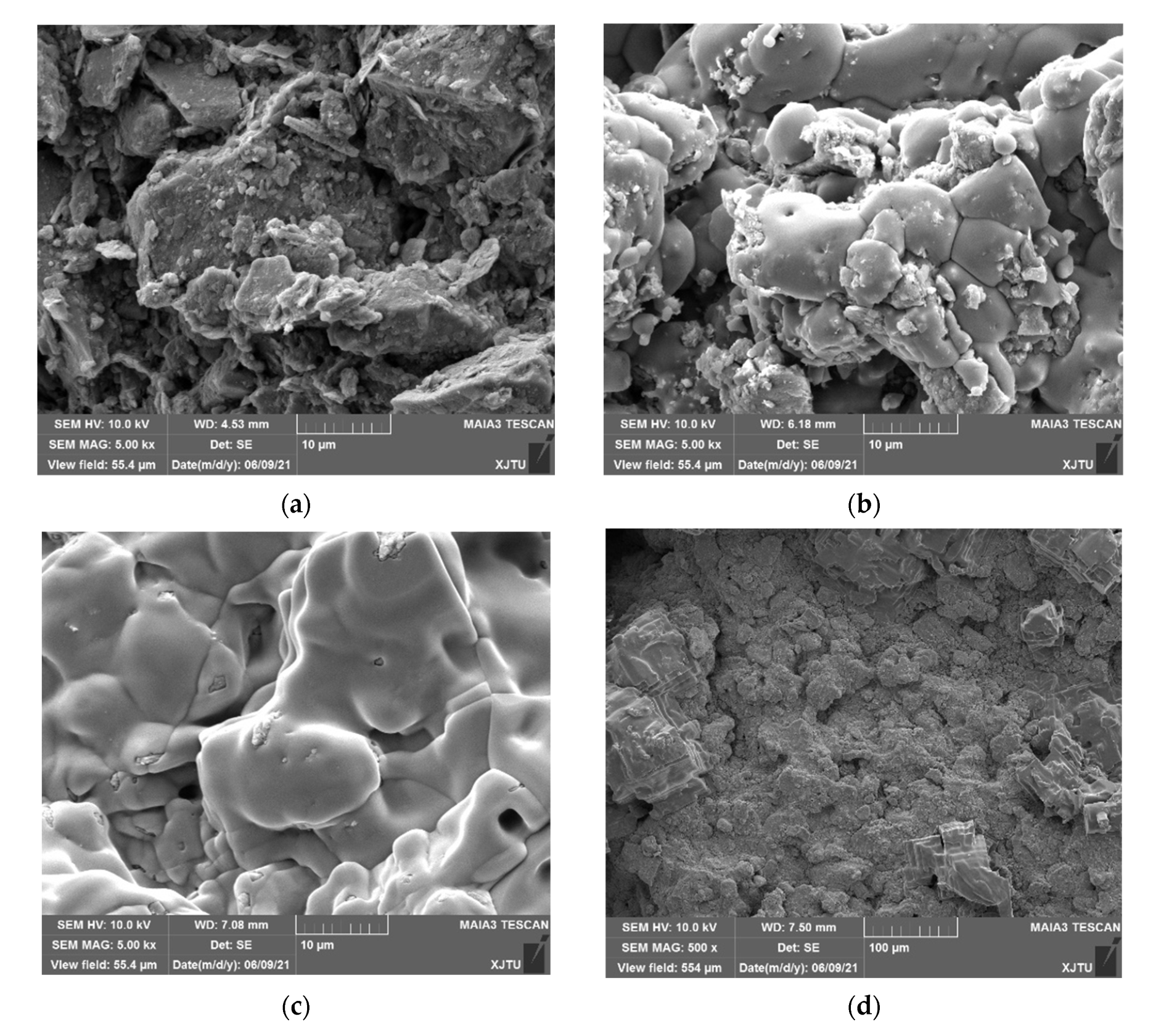
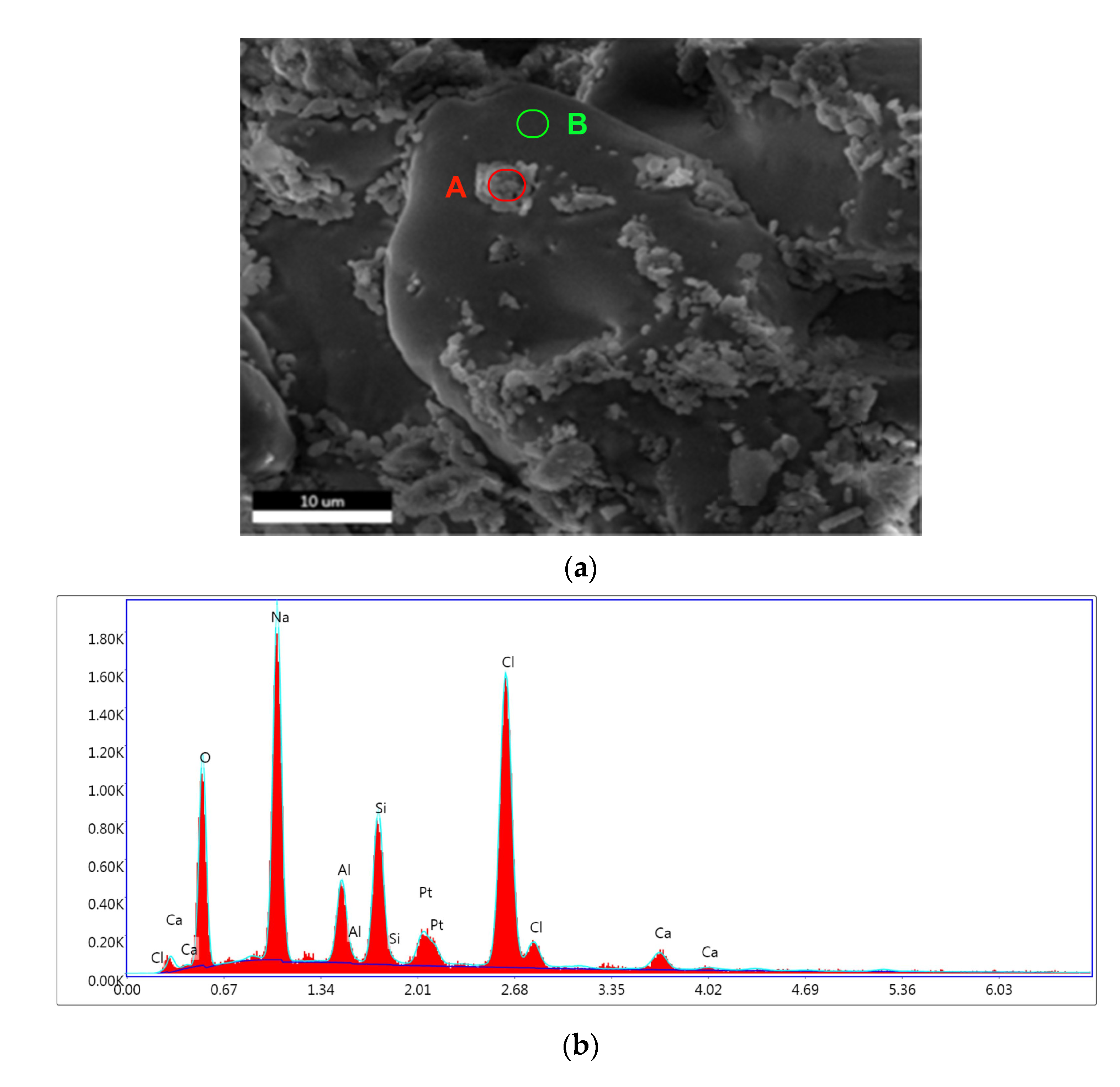
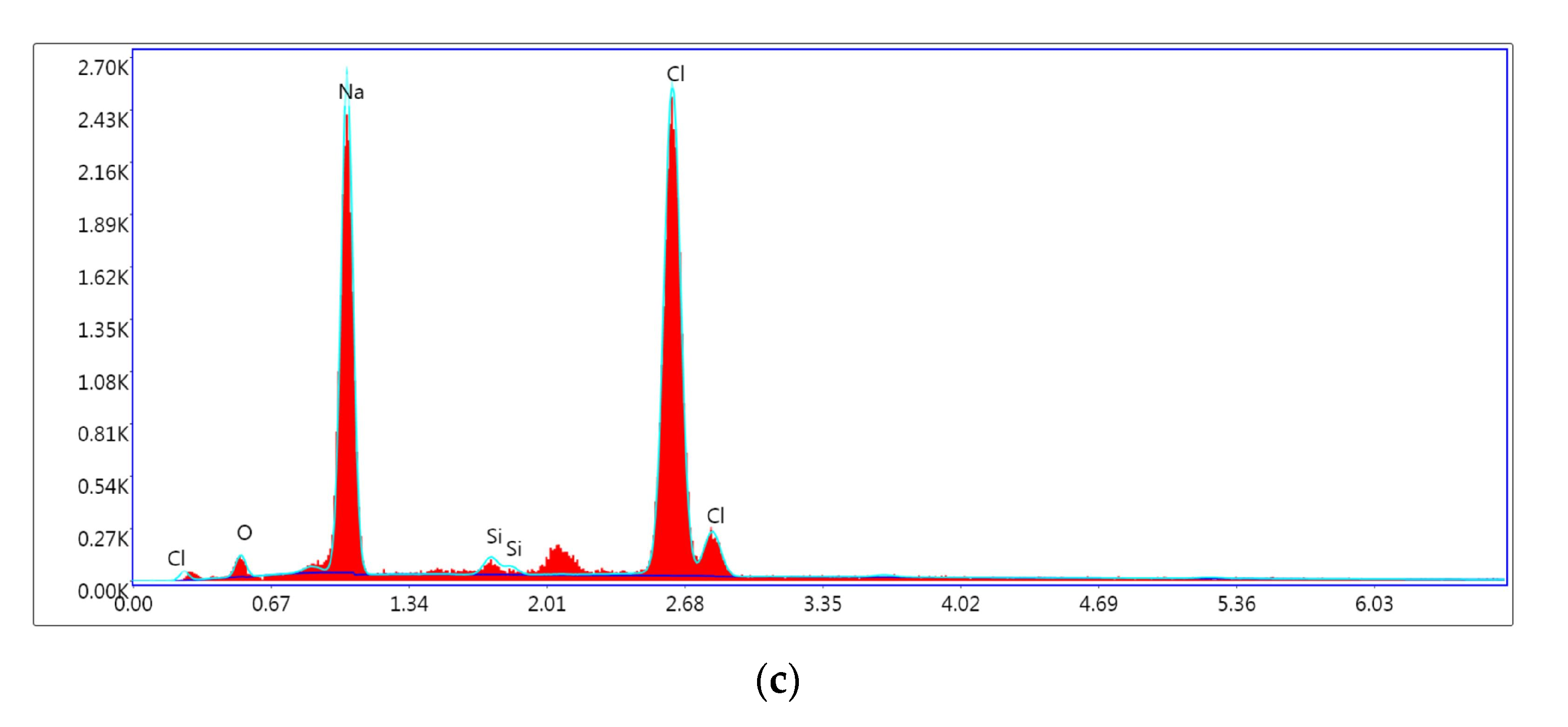
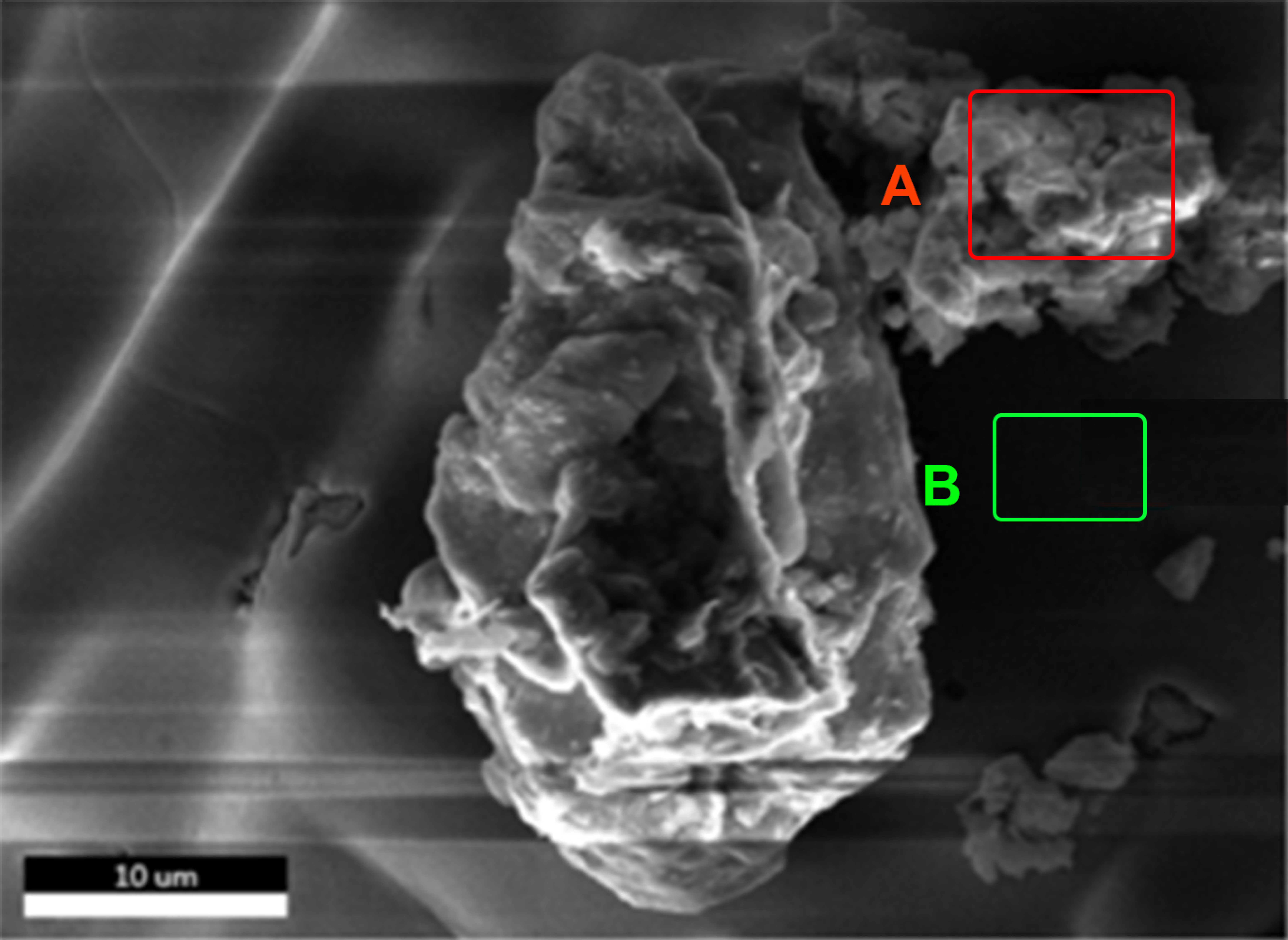
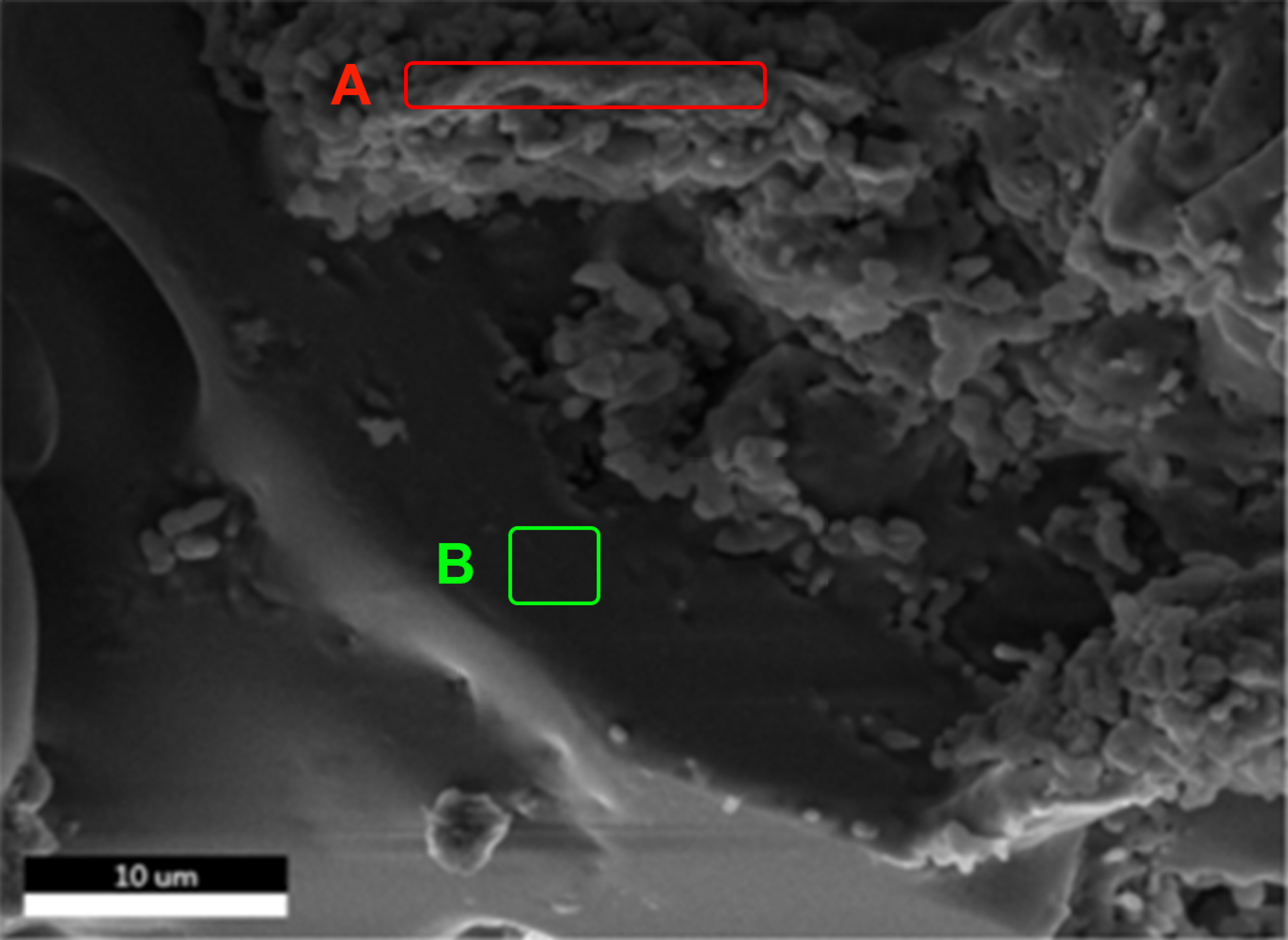
| Specific Gravity | Dry Density (g/cm3) | Liquid Limit | Plastic Limit | Plasticity Index | Granulometry (%) | ||
|---|---|---|---|---|---|---|---|
| Sand Content (4.75–0.075 mm) | Silt Content (0.075–0.002 mm) | Clay Content (≤0.002 mm) | |||||
| 2.69 | 1.57 | 35.6 | 17.1 | 18.5 | 0.3 | 82.7 | 17 |
| Number of the Sample | The Concentration of NaCl (%) | Salinization Degree |
|---|---|---|
| 1 | 0 | Non-saline soil |
| 2 | 3.6 | Weakly saline soil |
| 3 | 7.2 | Medium saline soil |
| 4 | 10.8 | Strongly saline soil |
| Element Content | Na | Cl | Si | O | Ca | |
|---|---|---|---|---|---|---|
| (%) | ||||||
| Zone A | 21.37 | 35.52 | 9.65 | 19.29 | 0 | |
| Zone B | 31.45 | 64.65 | 1.20 | 2.71 | 3.63 | |
| Element Content | Na | Cl | Si | O | Ca | |
|---|---|---|---|---|---|---|
| (%) | ||||||
| Zone A | 27.37 | 40.84 | 8.86 | 19.57 | 0 | |
| Zone B | 45.78 | 52.08 | 0 | 2.13 | 0 | |
| Element Content | Na | Cl | Si | O | Ca | |
|---|---|---|---|---|---|---|
| (%) | ||||||
| Zone A | 9.75 | 15.88 | 14.87 | 43.62 | 2.53 | |
| Zone B | 44.57 | 54.94 | 0.04 | 0.45 | 0 | |
Disclaimer/Publisher’s Note: The statements, opinions and data contained in all publications are solely those of the individual author(s) and contributor(s) and not of MDPI and/or the editor(s). MDPI and/or the editor(s) disclaim responsibility for any injury to people or property resulting from any ideas, methods, instructions or products referred to in the content. |
© 2023 by the authors. Licensee MDPI, Basel, Switzerland. This article is an open access article distributed under the terms and conditions of the Creative Commons Attribution (CC BY) license (https://creativecommons.org/licenses/by/4.0/).
Share and Cite
Wei, X.; Dong, L.; Chen, X.; Zhou, Y. Influence of Soluble Salt NaCl on Cracking Characteristics and Mechanism of Loess. Sustainability 2023, 15, 5268. https://doi.org/10.3390/su15065268
Wei X, Dong L, Chen X, Zhou Y. Influence of Soluble Salt NaCl on Cracking Characteristics and Mechanism of Loess. Sustainability. 2023; 15(6):5268. https://doi.org/10.3390/su15065268
Chicago/Turabian StyleWei, Xin, Li Dong, Xuanyi Chen, and Yunru Zhou. 2023. "Influence of Soluble Salt NaCl on Cracking Characteristics and Mechanism of Loess" Sustainability 15, no. 6: 5268. https://doi.org/10.3390/su15065268
APA StyleWei, X., Dong, L., Chen, X., & Zhou, Y. (2023). Influence of Soluble Salt NaCl on Cracking Characteristics and Mechanism of Loess. Sustainability, 15(6), 5268. https://doi.org/10.3390/su15065268






